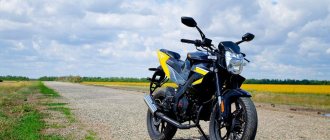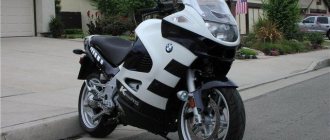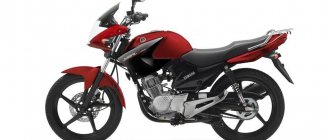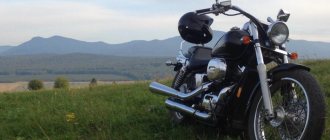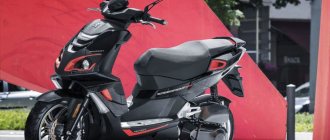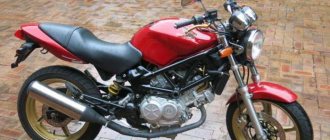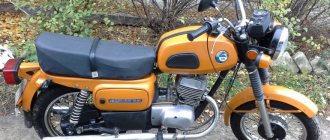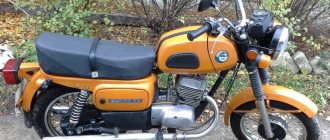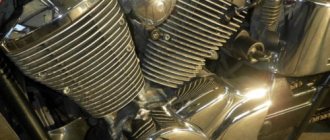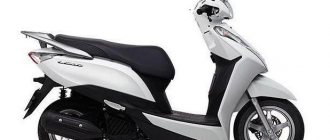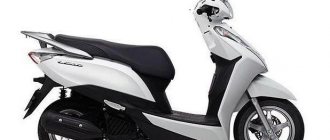| Honda Steed 400 (1988-1989) | Honda Steed 400 VLX (1990-1997) | Honda Steed 400 VCL (1995-1996) |
| Honda Steed 400 VSE | Honda Steed 400 VLS | Honda Steed 400 VLX (1998-2001) |
Honda Steed 400 cruiser model
appears on the Japanese market in 1988 in parallel with the older version of the Honda Steed 600. In the first years of production (until 1991), the model was in extremely low demand and there were even rumors that Honda was planning to end production of the motorcycle. However, by 1993, another boom in American-style motorcycles began in Japan, and the Steed 400 very quickly became a bestseller - within 10 years of production, the total number of Steed 400 and 600 sold reached 80,000 units.
Why did both versions exist at the same time? The fact is that in Japan, driver's licenses for motorcycles have different levels, depending on the driving experience. Thus, the Steed 400 could be used by any novice driver who had recently graduated from motorcycle school, while the Honda Steed 600 required a more advanced license.
The model was based on a 2-cylinder V-shaped liquid-cooled engine with a volume of 398 cm³, producing 30-31 hp. power and 32-33 Nm of torque. This engine was also installed on the Honda XL400V Transalp, Honda VRX 400, Honda Bros 400 and Honda Shadow 400 models.
Features of the Steed 400 include a classic steel duplex frame, front disc and rear drum brakes, simple suspension in the form of a conventional telescopic fork (VLS - springer) and a rear monoshock absorber, a 9-11 liter fuel tank (depending on the year and version), 5-speed gearbox and curb weight from 208 kg.
At first, there was only one modification of the Honda Steed 400 on the market (in addition, you could only choose a steering wheel - a curved or straight drag bar), which received the abbreviation VLX
(interpretation: V-Twin, Lowered, eXtended rake) - this is the designation of the standard version of the motorcycle.
In 1995, the model line was replenished with 2 modifications at once - VCL
(standby: V-Twin, Custom Limited) and
VSE
(standby: V-Twin, Special Edition).
The VCL
is a budget variant of the standard VLX, featuring the absence of a passenger backrest, a stock drag bar and a simpler saddle.
This version was 30,000 yen cheaper than the VLX. VSE
modification received a cast rear wheel in the style of Honda Magna and a curved steering wheel in stock. Both versions lasted until 1996, after which they were no longer offered.
In 1998, the Steed 400 line was replenished with a new modification - VLS
(decoding: V-Twin, Lowered, Springer front end). It features a unique style with a springer instead of a classic fork, a 21′ front wheel, a smaller fuel tank, ergonomics and overall dimensions. This version existed only during 1998.
2001 was the last year of production of the Honda Steed 400 model, which was slightly updated (added an exhaust afterburning system to comply with new environmental standards and other minor innovations) and finally rolled off the assembly line. In 1997, a new model, the Honda Shadow 400, was proposed as a successor to the Steed 400.
Main competitors in the class:
- Suzuki Intruder 400 / Suzuki LS400 Savage
- Kawasaki VN 400 Vulcan / Kawasaki EN400 Vulcan
- Yamaha XV400 Virago / Yamaha XVS 400 Drag Star
Brief history of the model
- 1988 - start of production and sales of the Honda Steed 400 model.
Model
: Honda Steed 400 VLX (Japan).
Frame number
: NC26-
100
XXXX~.
Factory designation
: NV400Cj.
- 1989 - no significant changes.
Model
: Honda Steed 400 VLX (Japan).
Frame number
: NC26-
105
XXXX~.
Factory designation
: NV400Ck.
- 1990 - The passenger backrest comes standard.
Model
: Honda Steed 400 VLX (Japan).
Frame number
: NC26-
110
XXXX~.
Factory designation
: NV400Cl.
- 1991 - model not produced.
- 1992 - no significant changes.
Model
: Honda Steed 400 VLX (Japan).
Frame number
: NC26-
115
XXXX~.
Factory designation
: NV400Cn.
- 1993 - fuel tank capacity increases from 9 to 11 liters.
Model
: Honda Steed 400 VLX (Japan).
Frame number
: NC26-
120
XXXX~.
Factory designation
: NV400Cp.
- 1994 - no significant changes.
Model
: Honda Steed 400 VLX (Japan).
Frame number
: NC26-
130
XXXX~.
Factory designation
: NV400Cr.
- 1995 - appearance of new modifications VCL and VSE. Starting this year, the model increases maximum power by 1 hp. and maximum torque by 1 Nm. The compression ratio is reduced from 10 to 9.8.
Model
: Honda Steed 400 VLX, Honda Steed 400 VCL, Honda Steed 400 VSE, Honda Steed 400 VSE (Japan).
Frame number
: NC26-
140
XXXX~ (VLX);
NC26- 139
XXXX~ (VCL);
NC26- 147
XXXX~ (VSE).
Factory designation
: NV400Ct; NV400CVs; NV400CMt.
- 1996 - no significant changes. The last year of release of the VCL and VSE modifications.
Model
: Honda Steed 400 VLX, Honda Steed 400 VCL, Honda Steed 400 VSE, Honda Steed 400 VSE (Japan).
Frame number
: NC26-
150
XXXX~ (VLX);
NC26- 144
XXXX~ (VCL);
NC26- 157
XXXX~ (VSE).
Factory designation
: NV400Cv; NV400CVt; NV400CMv.
- 1997 - model not produced.
- 1998 - appearance of the VLS modification. The standard VLX no longer has a stock passenger backrest and becomes a cross between the outgoing VLX and the budget VCL. The suspension settings are changed, the saddle height is reduced by 10 mm.
Model
: Honda Steed 400 VLX;
Honda Steed 400 VLS (Japan). Frame number
: NC26-
164
XXXX~ (VLX);
NC37-100-109
XXXX~ (VLS).
Factory designation
: NV400CBw; NV400CSw.
- 2001 is the last year of VLX production. The model receives an exhaust gas afterburning system and wiring for the installation of an alarm system.
Model
: Honda Steed 400 VLX (Japan).
Frame number
: NC26-
210
XXXX~, NC26-
211
XXXX~, NC26-
212
XXXX~.
Factory designation
: NV400CB1.
Design features
Honda Steed 400 is a light cruiser created specifically for the standards of American motorcyclists. The frame-type design was complemented by a lowered seat and telescopic front forks, despite the fact that some models were equipped with a springer.
The fuel tank was made in the shape of a drop and had a small volume. The seat was located as close as possible to the steering wheel, which, according to the designers’ idea, was supposed to bring dregster notes to the design of the motorcycle. The stepped seat design placed the passenger higher than the driver, and some models included an additional backrest.
An interesting fact is that during the entire production of the Honda Steed 400, the engine characteristics have never changed, but the popularity and demand for the motorcycle have remained at the same level.
Specifications
Technical characteristics of Honda Steed 400:
| Model | Honda Steed 400 |
| Motorcycle type | cruiser |
| Year of issue | 1988-2001 |
| Frame | steel tubular |
| engine's type | 2-cylinder, 4-stroke, V-shaped |
| Working volume | 398 cm³ |
| Bore/Stroke | 64.0 x 62.0 mm |
| Compression ratio | 10.0:1 - Steed 400, 1988-1995 9.8:1 - Steed 400, December 1995 to 2001 |
| Cooling | liquid |
| Number of valves per cylinder | SOHC, 3 valves per cylinder |
| Fuel supply system | carburetor, 2x Keihin 34 mm (VDD0) |
| Ignition type | transistor |
| Maximum power | 30.0 hp (22.0 kW) at 7500 rpm - Steed 400 (1988-1994) 31.0 hp (22.8 kW) at 7500 rpm – Steed 400 (1995-2001) |
| Maximum torque | 32.0 Nm (3.3 kg*m) at 5500 rpm – Steed 400 (1988-1994) 33.0 Nm (3.4 kg*m) / 5500 rpm – Steed 400 (1995-2000) 33.0 Nm (3.4 kg*m) / 6000 rpm – Steed 400 (2001) |
| Clutch | Multi-disc in oil bath, cable drive |
| Transmission | 5-speed |
| type of drive | chain |
| Front tire size | 100/90-19 57S 90/90-21 54S - VLS |
| Rear tire size | 170/80-15 77S |
| Front brakes | 1 disc, 296 mm, 2-piston caliper |
| Rear brakes | drum |
| Front suspension | telescopic fork - VLS |
| Rear suspension | pendulum with monoshock absorber |
| Motorcycle length | 2310 mm 2335 mm - VLS |
| Motorcycle width | 760 mm 705 mm – VLX with drag handlebar, VCL 865 mm – VSE 765 mm – VLS 890 mm – VLX (2001) |
| Motorcycle height | 1130 mm 1105 mm – VLX with drag handlebar, VCL 1120 mm – VSE, VLX (2001) 1115 mm – VLX (1998-2000), VLS |
| Wheelbase | 1600 mm 1620 mm – VLS |
| Seat height | 680 mm 670 mm - VLX (1998-2001) 650 mm - VLSD |
| Minimum ground clearance (clearance) | 140 mm 130 mm - VLX (1998-2001), VLS |
| Acceleration 0-100 km/h (0-60 mph) | 11.1 sec. |
| Maximum speed | 130 km/h |
| Gas tank capacity | 9.0 l – Steed 400 (1988-1992) 11.0 l – Steed 400 (1993-2001) 9.7 l - VLS |
| Motorcycle weight (dry) | 196 kg – Steed 400 (1988-1989) 199 kg – Steed 400 VLX (1990-1992) 201 kg – Steed 400 VLX (1993) 204 kg – Steed 400 VLX (1994-1997), VCL 203 kg – VSE, VLX (1998-2001) 211 kg – VLS |
| Motorcycle weight (curb) | 208 kg – Steed 400 (1988-1989) 211 kg – Steed 400 VLX (1990-1992) 214 kg – Steed 400 VLX (1993) 217 kg – Steed 400 VLX (1994-1997), VCL 216 kg – VSE 215 kg – VLX (1998-2001) 223 kg – VLS |
Disadvantages of the model
High quality and reliability did not save the Honda Steed 400 from its shortcomings. Despite its belonging to the cruiser category, the motorcycle is not one.
The reason for this lies in the suspension: both the front and rear are too stiff and have little travel, which is why long trips quickly tire the driver. The reliable engine lacked power, especially if the motorcycle was carrying a passenger.
The seat close to the steering wheel and low seating position were not always comfortable for tall drivers.
The downside of the Honda Steed 400 was its small fuel tank - only 11 liters, which significantly limited its autonomy and reduced its range.
Reviews
Reviews about Honda Steed 400:
Expand Collapse
It was bought by me after a short and very superficial viewing for 97 thousand. The set includes small arches and ears (they turned out to be a cool company), straight-through fish, and battered trunks and frames for them.
At first, the following problems emerged: the gasket under the antifreeze filler neck leaked (original 75r), the carbs required synchronization and cleaning, a weak charge was cured by restoring the wire in the generator-relay section. Dying rubber bands in the brake machine. Unfortunately, I’m putting off replacing it until I can drive like this.
For a beginner, I think this is a good motorcycle. The controls are clear and the seating position is comfortable. The dimensions are small, although it looks much larger than Viraga or Intruder. Low center of gravity. Forgives many mistakes.
Consumption is 4-5 Russian (if you come to a gas station on reserve, they can pour from 8 to 10 liters into a 9 liter tank.) liters in the city-highway. Comfortable speed is 100-110 km/h. Then the shaking begins (fingers then ring), deflation (maybe the glass solves the problem, but 400 cm is too heavy) and other delights of a small-volume chopper. By the way, I didn’t overclock it to more than 145, there seemed to be some reserve. Together (85kg+75kg) it goes up to 130 km/h, which is normal for the “itch” of this class.
In half a season I covered about 7000 km. I am almost completely satisfied with the motorcycle (weak engine). 400cc is already not enough and very often I feel like a vegetable, although for such a dynamic city as DS its motor is enough. If I were again choosing my first chopperoid up to 100 sput, I would take the steed again.
I skated on Steed for two seasons. Among the advantages, I would like to note its beauty, reliability (in 2 years it has never failed, it starts with half a turn, except for changing the oil - I did nothing at all), cork-permeability.
Among the minuses is a weak front brake (although if you use both the front and rear at the same time, you can slow down), a small saddle (although my big ass is more likely to blame for this), and 30 horses, which, together with the already mentioned part of the body, did not allow the conic to accelerate more than 120 km according to the speedometer. Although in the city, where the operation mainly took place, there were no complaints about the dynamics, in any case, you can stay in the flow without cranking the engine until it rings.
In general, I liked the mot and left the most pleasant memories. Good luck to him with his new owner!
Citizens, this is the perfect bike for the first season. The dry frame partly compensates for the low power of the engine, giving the output a light, passable car that can scoot perfectly both on the highway, without breaking out of the cruiser speed/comfort framework, and on country roads, demonstrating grip in low gears and stability on uneven roads, and even knead shit is no worse than the brainchild of the domestic motorcycle industry.
It makes sense to take a motorcycle if you have not yet decided whether you want to connect your life with two-wheelers. It is quite difficult to clean on the road, it is inexpensive and open to tuning. Another thing is that it is tuned quite rarely - rather than buying a 750 engine from Shadova for it and tuning it yourself, it’s easier to sell the Konik into good hands and buy a new one. Although, as a designer, Steed is very, very good. If desired, it can be equipped with spare parts from Junker, fenders and running boards from the Urals, cameras from Minsk, and even a Ural lever fork, which turns the kataka into a chic mess of avant-garde exterior.
In short, based on the results of the first season, the impressions are only positive. It's a pity to even give it away.
Garage installation of Honda Steed NV 600 from MD CustomS Greetings to all motorcycle enthusiasts.
This is my second project, which I would like to present with pleasure to my brothers. But first I want to express my gratitude to my large family, my wife and children for their understanding and support. And also to my friends, and especially Alexey Shalaev, who did not remain indifferent. This time I will not burden the reader with the agony of choice, thoughts on how I chose the paint and other rubbish. But I want to get straight to the point and talk about building a custom car based on the Honda Steed NV 600.
Anyone who doesn’t want to read the text, for example, is tired after work or is simply annoyed by reading, I invite you to immediately look at the photo.
So - I got the motorcycle in post-accident condition. He was, to put it mildly, shaken. And there was nothing attractive about it except the engine and flights of fancy. Everything iron and plastic, as well as electric, was in such a ruined state that I was simply horrified by how it drove at all. But of course, all this affected the price, which suited me quite well. I bought it at a symbolic price of 50 thousand rubles, which by today’s standards is not even a “thousand” of greenery. As for the accident itself, according to the descriptions of the previous owner, he drove it to the car. He says it’s not his fault, but that doesn’t really matter. As a result, the steering wheel was bent, and the most difficult thing was the steering column. Surprisingly, the wheel, traverses, fork and even the wing were intact. The motorcycle was seized before me. The beaver was not tricky and consisted of removing the subframe and installing a single seat. In principle, that's all. There wasn't even a rear wing. Instead of a broken plastic seat, the space was covered with an old jacket of nice leatherette. My eyes rolled across the floor when I removed it and saw a fuel pump tied to a string, and wires melted from contact with the mufflers. On the plus side, as the former owner assured me, the carburetors were adjusted and the engine was ventilated. I bought it in Tyumen, I already wrote about it briefly. By the way, despite everything, the former owner turned out to be a very good and sympathetic person. I registered it without any problems, by blinding the police. That is, having installed a standard wing, seat, stopper and plastic, the steering wheel was straightened in a vice. It's good that it was all included. And after registration he began to work. Worked in winter. It flew by quickly or even unnoticed. The steering column was put in place on a makeshift slipway with the help of my good friend. And that was the hardest thing. Geometry control was carried out using a laser level and such and such a mother. And then the revision began. The frame appears to be somewhat overcooked. Boxes from a Soviet-era Pannonia motorcycle were installed. All the electrics and the fuel pump are hidden in them. I tried to follow the contour of the frame according to the shape of the drawers. I wanted to make the steering wheel high, but not so high that my hands would become numb. I didn’t come up with the shape of the steering wheel right away. At least ten sketches were drawn, but they all repeated already known rudders. I wanted a unique one, which was invented by Mendeleev in a dream. Hahaha. My wife looked at me like I was crazy when I grabbed a pencil in the morning. But here, too, the implementation was complicated by the need to bend the pipe on rollers. A week of searching and the pipe is bent. Many will find the lack of adjustment a controversial decision, since the steering columns are welded into the steering wheel. But for me everything is convenient. The rear fender is made from the remains of a Dnepr motorcycle fender. Accordingly, all the fasteners, the battery box, the rear fender struts, the license plate and brake light mount, as well as the seat are made of metal. The stock mufflers were unsaleable, so new ones were made from stainless steel. The design is semi-straight-through with flutes. The sound is moderately loud, but very bassy. During development and assembly, we purchased and installed the second cylinder cover gasket, brake disc, steering handles, turn signals, extended cables and brake hose, headlight, brake light from the same ZIL, tires and consumables.
After fitting, I started painting. The frame, pendulum, boxes, traverses, fork cups, wheels, speedometer and brake light housings, front fender and license plate mount are painted with polymer powder paint and varnish. The tank and rear fender are painted with Candy paint with flakes. The middle part of the tank and wing is sanded with an emery wheel and also covered with candy. The tank and wing are pin-stamped. The painting design was invented by me and executed by the wonderful master Alexey Cheredov. Pinstriping was invented by Alexey himself. To complete the details, certain accents are made of bronze. On the crossbar, handlebar grips, rear fender mounting bolts, headlight mounting, mufflers and running boards. The saddle is also made independently. I have long wanted to try my hand at leather embossing. I was pleased with the result. I got exactly what I had in mind. It took a week to make, including embossing, drying, gluing, stitching and painting. For the first time I think it's good. What did you want to implement, but for objective reasons refused? I wanted to remove the airbox and free up the beautiful front cylinder cover for viewing. I refused because I would have to install zero-resistance filters and destroy the engine due to the huge amount of dust and sand. It’s a pity that, like in Moscow, our roads are not washed with shampoo. I wanted to remove the left and right stock remote controls. The right one was removed. But I left the left one for convenience and safety reasons. Yes, I have a small box for the steering wheel with small turn and signal buttons. But, having tried it on, I realized that I couldn’t use my leggings, and even with gloves. I wanted to not install the front wing. But, after driving a few kilometers, I came home and installed it. It’s not pleasant when sand flies in your face - once, and it knocks off the paint - twice. I would also like to fix all the chrome plating, as the chrome has bubbled everywhere from age. But we cannot solve this issue in any way. Chemical chromium is not taken into account, there is a lot of such stuff.
And my little point is the inscriptions in Latin. I named the motorcycle Custos solis - Guardian of the Sun. The words Libertas - Freedom / Fides - Faith / Honor - Honor / Iustitiae - Justice are written on the saddle. These words and the name reflect all my emotions invested in this motorcycle.
Now let's get down to business.
How it was:
How I made it: Thanks everyone for watching. Of course, there are no perfect motorcycles and this one is no exception. Someone will want to add or subtract something, but this is my picture and that’s how I see it))) Good luck to everyone on the roads and have a great motorcycle season 2021!
Honda Steed 400 reviews
Owners of the Japanese motorcycle, after several years of operation, note its reliability and beauty: it starts quickly and easily, does not require any maintenance except for regular engine oil changes.
Among the shortcomings are the ineffective front brake, a small seat and difficulties in accelerating the motorcycle to 120 km/h. There are no special complaints about the dynamics of the motorcycle if it is used in urban areas: it handles perfectly in traffic and you don’t have to turn the engine off.
The lack of engine power is compensated by a dry frame, which ultimately allows you to get an easy-to-control motorcycle that meets the parameters of cruiser models. On uneven roads, Honda demonstrates miracles of stability and can overcome simple off-road conditions.
Steed 400 is the best option for those who are just deciding whether to purchase a motorcycle as a permanent means of transport: its affordable price, wide tuning possibilities and reliability make it an ideal option. If necessary, Honda can be equipped with spare parts from Ural, Junker and other domestic motorcycles, which is an additional advantage of the model of the Japanese concern Honda.
Honda Steed 400: photos, technical characteristics, pros and cons, reviews on News4Auto.ru.
Our life consists of everyday little things that in one way or another affect our well-being, mood and productivity. I didn’t get enough sleep - my head hurts; I drank coffee to improve the situation and cheer myself up - I became irritable. I really want to foresee everything, but I just can’t. Moreover, everyone around, as usual, gives advice: gluten in bread - don’t go near it, it will kill you; A chocolate bar in your pocket is a direct path to tooth loss. We collect the most popular questions about health, nutrition, diseases and give answers to them that will allow you to better understand what is good for your health.
Advantages of a motorcycle
The main advantage of the Honda Steed 400 is the unpretentiousness and reliability of the engine: its service life exceeds 250 thousand kilometers.
The rigid suspension also played a role, which, in combination with a lower center of gravity, ensures excellent handling of the motorcycle.
The advantage of the model is its design: outwardly it does not differ from more solid and powerful competitors with relatively modest engine performance.
The motorcycle is often used as a basis for creating choppers, and the main changes in most cases affect only the appearance, keeping the power unit unchanged.
The maximum speed of the Steed 400 is 130-140 km/h, which, coupled with excellent dynamics, creates the impression of more power than it actually is.
Prices
The successful design of the motorcycle has maintained its popularity after so many years since the end of production. You can buy a Honda Steed 400 today on the secondary market. The cost of a model is influenced by various factors - general technical condition, year of production, availability of tuning and other little things.
The minimum price of a motorcycle is 85 thousand rubles, the maximum is 200 thousand.
Estimated cost
The Honda Steed 400 has not been produced for a long time , but its popularity has not yet decreased, and this is largely due to the successful design of the motorcycle.
Of course, it’s impossible to buy a new motorcycle now, but the secondary market offers a lot of options .
The cost of this motorcycle depends on many factors, including the year of production, technical condition, absence or presence of alterations, etc.
The price point for the Honda Steed 400 starts at 85,000 rubles. and reaches 200,000 rubles.
Due to its lightness, ease of use and reasonable price, a mini snowmobile is suitable not only for fishermen and hunters, but also for lovers of winter travel.
But you can learn everything about suitable equipment for driving this type of vehicle from this article.
